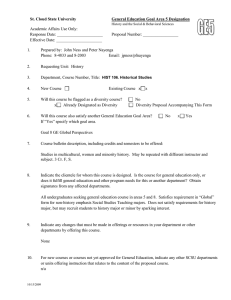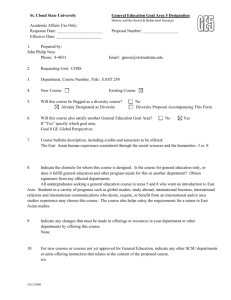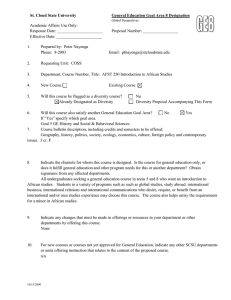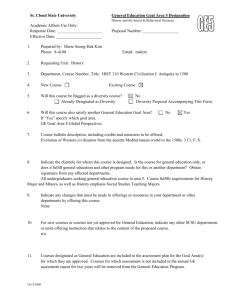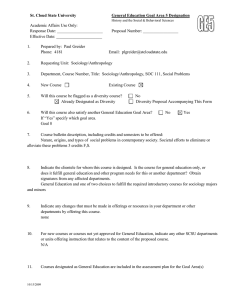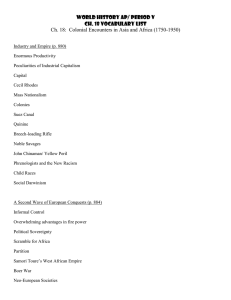St. Cloud State University General Education Goal Area 5 Designation
advertisement
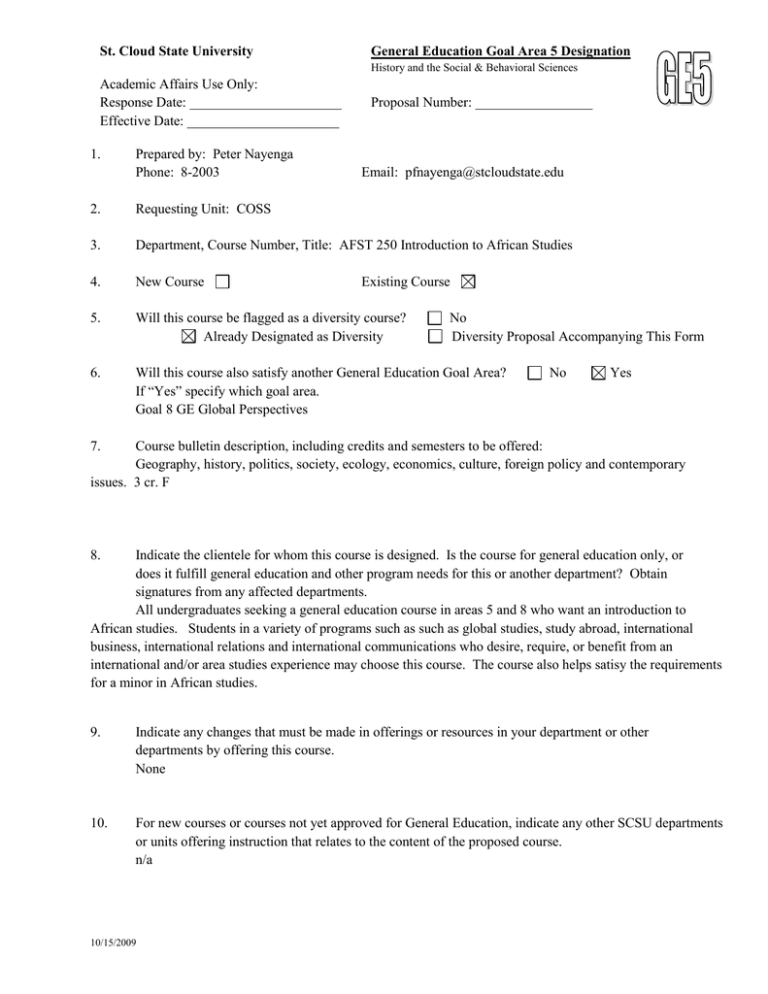
St. Cloud State University General Education Goal Area 5 Designation History and the Social & Behavioral Sciences Academic Affairs Use Only: Response Date: ______________________ Effective Date: ______________________ 1. Prepared by: Peter Nayenga Phone: 8-2003 Proposal Number: _________________ Email: pfnayenga@stcloudstate.edu 2. Requesting Unit: COSS 3. Department, Course Number, Title: AFST 250 Introduction to African Studies 4. New Course 5. Will this course be flagged as a diversity course? Already Designated as Diversity 6. Will this course also satisfy another General Education Goal Area? If “Yes” specify which goal area. Goal 8 GE Global Perspectives Existing Course No Diversity Proposal Accompanying This Form No Yes 7. Course bulletin description, including credits and semesters to be offered: Geography, history, politics, society, ecology, economics, culture, foreign policy and contemporary issues. 3 cr. F 8. Indicate the clientele for whom this course is designed. Is the course for general education only, or does it fulfill general education and other program needs for this or another department? Obtain signatures from any affected departments. All undergraduates seeking a general education course in areas 5 and 8 who want an introduction to African studies. Students in a variety of programs such as such as global studies, study abroad, international business, international relations and international communications who desire, require, or benefit from an international and/or area studies experience may choose this course. The course also helps satisy the requirements for a minor in African studies. 9. Indicate any changes that must be made in offerings or resources in your department or other departments by offering this course. None 10. For new courses or courses not yet approved for General Education, indicate any other SCSU departments or units offering instruction that relates to the content of the proposed course. n/a 10/15/2009 11. Courses designated as General Education are included in the assessment plan for the Goal Area(s) for which they are approved. Courses for which assessment is not included in the annual GE assessment report for two years will be removed from the General Education Program. The Requesting Unit understands and recognizes the above conditions. 12. Provide a concise explanation of how the following goal is a “significant focus” of the proposed course. Goal Area 5: History and the Social & Behavioral Sciences Develop understanding of human societies and behaviors, and of the concepts, theories, and methods of history and the social sciences. Through the examination of topics in “historical and social and behavioral studies” from Africa students will acquire a familiarity with major events and figures as studied via different African societies and behaviors. The student will also develop skills in critical reading of both primary and secondary sources, in research, in the comprehension of textual and lecture material, in class discussion, and in the composition of essays. 13. In order for a course to be designated as fulfilling Goal Area 5, it must address at least 4 of the 5 student learning outcomes (SLOs) below. Check the SLOs below that are focused on in the proposed general education course. 1. Describe or use the methods and data by which historians, social scientists, or behavioral scientists investigate human conditions. 2. Analyze human behavior, cultures, and social institutions and processes from the perspectives of history or the social and behavioral sciences. 3. Develop explanations for and explore solutions to historical or contemporary social problems. 4. Reflect upon themselves in relation to family, communities, society, culture, and/or their histories. 5. Apply and critique alternative explanatory systems or theories about human societies and behaviors. 14. Discuss how each Student Learning Outcome checked above is achieved in this course. (Note: Although descriptions of typical assignments or types of assignments may be part of this discussion, it is not appropriate to submit copies of actual assignments.) Students are required through written and oral course work, i.e., instructor generated examination questions, student generated theses (papers), and student oral presentations to: 1) find and identify primary and secondary source materials and use them as illustrations or demonstrable proofs in formulating a historical argument. At this introductory level, students are provided with “readers” of such works in English translation. 2) compare and contrast historical processes as introduced in the course and illustrate them with specific historical patterns (case studies) as discussed in the course. For example, students will by comparing and contrasting gender roles, artistic and literary developments, differences in cuisine, and religious differences etc., in different African cultural areas become able to analyze and understand differences and change over time. 10/15/2009 3) explore solutions for historical problems many of which still have resonance in the present. For example, students will analyze ideological, religious and cultural differences and the solutions developed between different people such as Muslim-Nativist interactions, European-African interactions, interactions between different ethnolinguistic groups, etc., or discussion of disputed geographic territories such as between Libya and Chad and Uganda and Buganda. 4) cause both international and U.S. students to reflect upon themselves in relations to another culture substantially different from their own. 5) apply and critique different theories about human societies and behaviors. For example, students will demonstrate the ability to discuss Marxist-Leninist theories of economic and social development as well as market driven concepts, and Marxist-Leninist theories of political organization with that of liberal-democratic models. 15. List or attach the Course Outline (adequately described and including percentage of time to be allocated to each topic). Curriculum Committees may request additional information. Topics larger than 20% need to be broken down further. Indicate in your course outline where the Student Learning Outcomes checked above are being met. 5% Introduction set the course requirements and format, and delineate the physical area to be studied 15% Land forms, climate and resources of Africa establish the physical features, climate, and resource base of the area 20% The heritage and background of Africa examine the temporal processes of change in Africa and consequent important events, persons, and concept 20% The humanities and patterns of communication in Africa develop an appreciation for the aesthetic and creative aspects of African life in language, literature, art, music, etc 20% Social institutions in Africa understand the characteristics of social institutions (such as education, religion, family, etc.) in Africa, the relationships among the social institutions, and the ways they shape individuals' lives. 15% Africa in the contemporary era explore a variety of contemporary issues/challenges in East Asia; social transformations of African cultures, peoples, and societies; and social forces that promote those changes. 5% Conclusion assess and reflect on the learning accomplished in the course. Discuss further learning and growth. 10/15/2009
